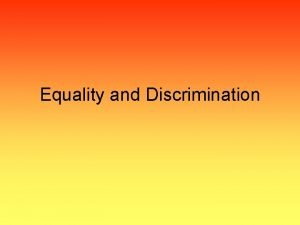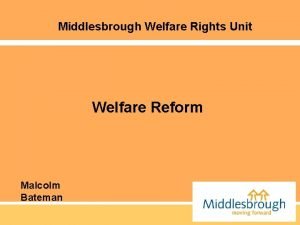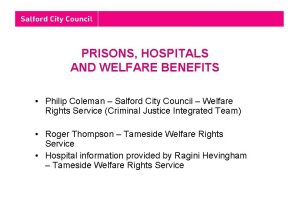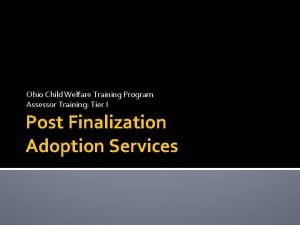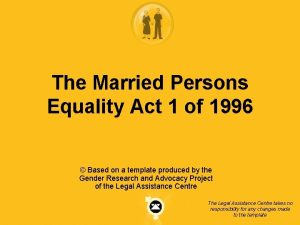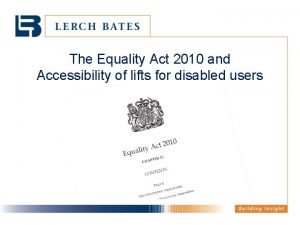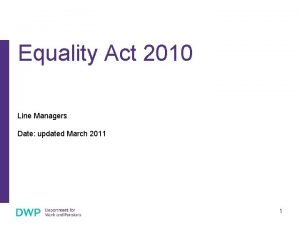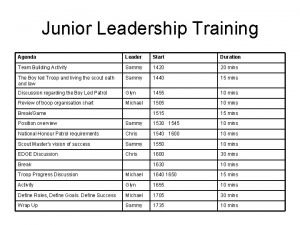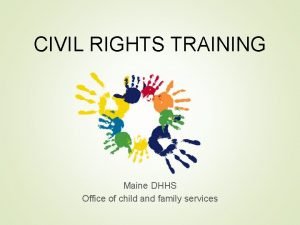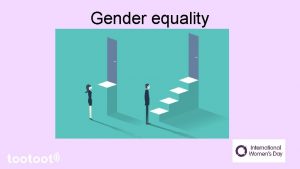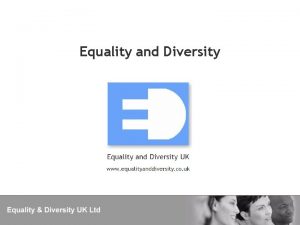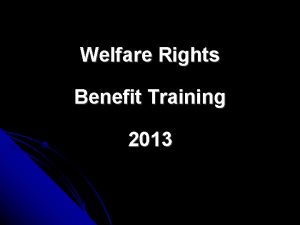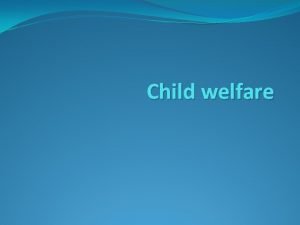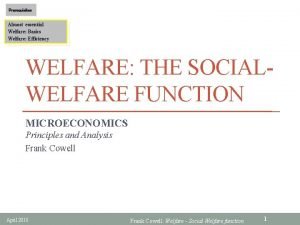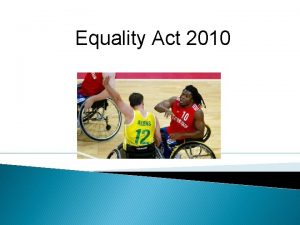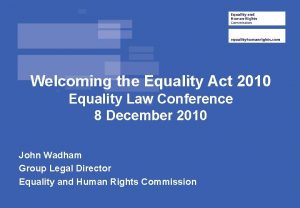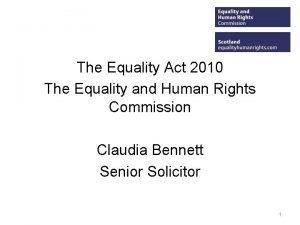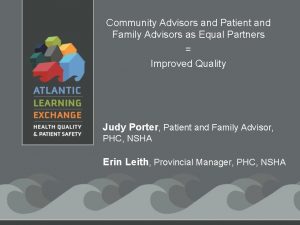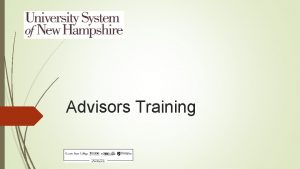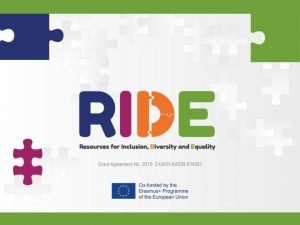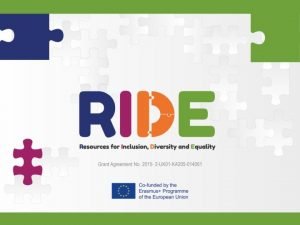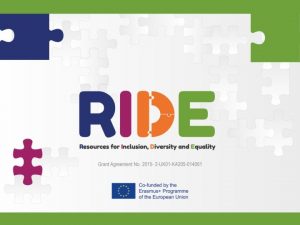Equality Act Training For Welfare Rights Advisors Agenda





























- Slides: 29

Equality Act Training For Welfare Rights Advisors

Agenda for the training § § § § What is discrimination? Who is protected? Elements of a discrimination claim? How is a claim brought? Who are claims brought against? Identifying potential claims Referring cases

What is discrimination? § Discrimination is the unequal treatment of an individual or individuals on the grounds of one of the protected characteristics. § Claims for discrimination are issued under the Equality Act 2010 [‘EQA’] which consolidated all the previous different legislation for discrimination.

Who is protected? § Protected Characteristics § § § § § age; disability; gender reassignment; marriage and civil partnership; pregnancy and maternity; race; religion or belief; sex; or sexual orientation.

s. 6 EQA - Disability § A disability is defined as: § a physical or mental impairment; § which has a substantial and long term adverse effect on a persons ability to carry out normal day to day activities. § “Substantial” is considered as “more than trivial”. § Long term is where a condition has or is likely to last more than 12 months.

Examples of Disabilities • • Anxiety Depression Arthritis Severe IBS/Crohns Cancer Down Syndrome ME/CFS Fibromyalgia

Elements of a discrimination claim § S. 13 EQA ‘Direct Discrimination’ § Direct Discrimination occurs when a person treats another person less favourably because of one of the protected characteristics. § Importantly there is no proportionality defence but a claim for direct discrimination is often difficult to establish.

Examples § If a service user is attending Work Related Activity and is not put forward for employment/training opportunities because they are disabled § If a service user is told that they cannot attend certain premises because they are disabled § If support is removed from a service user because they are disabled

Elements of a discrimination claim § S. 15 EQA ‘Discrimination arising out of a disability’ § Discrimination arising out of disability arises when a person is treated less favourably because of something arising out of a disability and the Respondent / Defendant cannot show that this treatment is a proportionate way of achieving a legitimate aim.

Example § A service user suffers from agoraphobia, they are told that they must attend a Work Focused Interview at their local JCP. The service user fails to attend and is sanctioned. § A service user suffers from anxiety, they are told they must attend group training sessions by their WRA provider. The service user fails to attend and is sanctioned.

Elements of a discrimination claim § S. 19 EQA Indirect Discrimination § Indirect discrimination is where a provision, criterion or practice is applied to everyone however it puts a person / people at a disadvantage when compared to others who do not share that particular protected characteristic.

Examples § The DWP refers a service user to a work programme provider. The DWP fail to inform the work programme provider that the service user suffers from a disability. Suitable support is not arranged for the service user. § A local JCP does not refer their disabled service users to a specialist disability trained advisor. § A local JCP gives all jobseekers a standardised jobseekers agreement.

Elements of a discrimination claim § S. 20/21 EQA ‘Failure to make reasonable adjustments’ § A duty to make reasonable adjustments arises when: § a provision, criterion or practice a disabled person at a substantial disadvantage in comparison with persons who are not disabled, to take such steps as it is reasonable to have to take to avoid the disadvantage; § where a physical feature puts a disabled person at a substantial disadvantage in comparison with persons who are not disabled, to take such steps as it is reasonable to have to take to avoid the disadvantage;

Elements of a discrimination claim § where a disabled person would, but for the provision of an auxiliary aid, be put at a substantial disadvantage in comparison with persons who are not disabled, to take such steps as it is reasonable to have to take to provide the auxiliary aid. § A claim arises when there is a failure to comply with this duty.

Examples § A local JCP does not refer their disabled service users to a specialist disability trained advisor. A service user asks for a specialist advisor and is told that one is not going to be made available § A service user with anxiety is required to attend a work focused interview at her local JCP. She asks for a taxi to be provided, the DWP refuse to provide one.

Elements of a discrimination claim § S. 26 EQA ‘Harassment’ § Harassment is when: § A person engages in unwanted conduct related to a relevant protected characteristic, and § the conduct has the purpose or effect of § violating another person’s dignity, or § creating an intimidating, hostile, degrading, humiliating or offensive environment for that person.

Examples § A service user attends a work programme provider. Upon attending they are told by their contact that it is a nightmare finding work for disabled people as noone wants to employ them. § A service user is struggling to get up some stairs to a medical assessment due to problems with mobility. The assessor states that they must hurry up as they don’t have all day.

Elements of a discrimination claim § S. 27 EQA ‘Victimisation’ § A person victimises another person if a person is subjected to a detriment because— § a person has done a protected act, or § A person believes that the person has done, or may do, a protected act.

Elements of a discrimination claim § Each of the following is a protected act § (a)bringing proceedings under the EQA; § (b)giving evidence or information in connection with proceedings under the EQA; § (c)doing any other thing for the purposes of or in connection with the EQA; § (d)making an allegation (whether or not express) that A or another person has contravened the EQA.

Examples § A service user attends a work focused interview. They tell the advisor that the work related activity they are to be provided is not suitable for them due to their disability. The service user is sanctioned for failing to comply with the requirement to take part in work related activity. § A service user asks their work programme provider not to put them in group sessions as they suffer from anxiety. The work programme provider stops offering the service user their support.

How is a claim brought? § Discrimination claims can been issued within the Employment Tribunal or the Civil Courts. § Part 5 of the Equality Act deals with discrimination claims arising from work or work related activity. Therefore all claims that are issued against employers or work providers are issued in the Employment Tribunal under this part of the Act.

How is a claim brought? § Part 3 of the Equality Act deals with discrimination claims arising from service providers. Therefore all of these types of claims are issued in the Civil Courts under this part of the Act. § With work programme providers it can be very difficult to identify whether the claim should properly be brought in the Employment Tribunal or the Civil Courts.

How is a claim brought? § In the Employment Tribunal discrimination claims are brought against an employer or work provider. Claims can also be issued against individual employees who have committed the acts of discrimination as well as additional Respondents. § In the Civil Courts discrimination claims are issued against Service Providers, including public bodies, who have committed the acts of discrimination.

How is a claim brought? § To issue a claim in the Employment Tribunal generally you must do so within 3 months less 1 day of the act of discrimination if it’s a one off act of discrimination, or, if it’s a series of acts, from the last act of discrimination. § To issue a claim for discrimination in the Civil Courts generally you must do so within 6 months less 1 day of the act of discrimination if it’s a one off act of discrimination, or, if it’s a series of acts, from the last act of discrimination. § There is potential to argue the discrimination is a continuing act however often this is a difficult argument to establish.

How is a claim brought? § For Employment Tribunal cases the procedure is fairly straightforward, commence ACAS conciliation and when this is finished submit an ET 1 Online and either pay a fee or complete a fee remission and send it off. § For Civil Court cases a pre-action letter must be sent and the claim must then be issued and, where appropriate, served.

How to identify potential discrimination claims § Questions such as the following will assist: § Has your service user been treated differently in comparison to others? § Do you feel that they have been treated differently due to a protected characteristic or its effect upon them? § Have there been any specific comments made in relation to the protected characteristic? § Have they complained and been treated differently? § Are there any rules / procedures that put them at a disadvantage when compared to other people?

Referring Cases § Stephensons are funded to provide advice through Civil Legal Advice and are one of 3 providers of discrimination advice nationwide. § Callers must be passed through a gateway, run by Agilisys, and are then randomly assigned.

Referring Cases § 1. 2. 3. To ensure that the case is referred to Stephensons take the following steps: Call Ryan Bradshaw on 01942 77 41 62 He will set up a file on Stephensons’ system The service user can then ask to be put through to Stephensons due to a ‘pre-existing relationship’.

Questions & Answers
 R. a 9344
R. a 9344 Formal equality vs substantive equality
Formal equality vs substantive equality Substantive equality vs formal equality
Substantive equality vs formal equality Welfare rights middlesbrough
Welfare rights middlesbrough Animal cell plant cell venn diagram
Animal cell plant cell venn diagram Venn diagram for animal and plant cells
Venn diagram for animal and plant cells Welfare rights salford
Welfare rights salford Welfare rights neath
Welfare rights neath Similarities between animal rights and animal welfare
Similarities between animal rights and animal welfare Health and social care unit 2
Health and social care unit 2 Agenda sistemica y agenda institucional
Agenda sistemica y agenda institucional Positive rights vs negative rights
Positive rights vs negative rights Define littoral rights
Define littoral rights Moral duties
Moral duties Legal rights and moral rights
Legal rights and moral rights Negative right
Negative right Negative rights
Negative rights Negative right
Negative right Positive rights and negative rights
Positive rights and negative rights Adoption assessor training ohio
Adoption assessor training ohio Macbeth summary
Macbeth summary Married persons equality act 1 of 1996
Married persons equality act 1 of 1996 Equality act lift
Equality act lift Equality act 2010
Equality act 2010 Leadership training agenda
Leadership training agenda Usda civil rights training
Usda civil rights training Civil rights training child nutrition programs
Civil rights training child nutrition programs Federally protected classes
Federally protected classes Advant edge advisors
Advant edge advisors Uf clas advising appointment
Uf clas advising appointment

